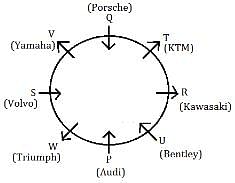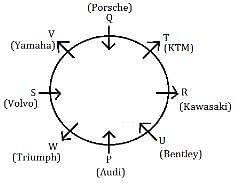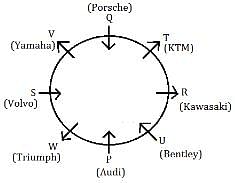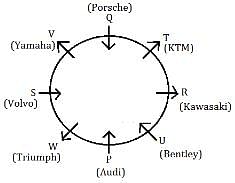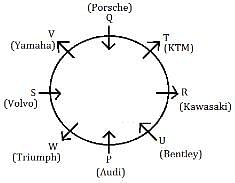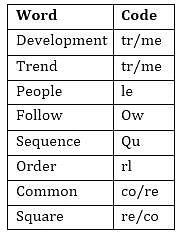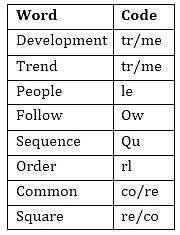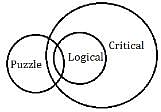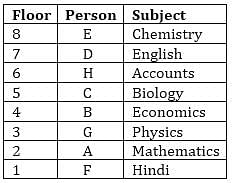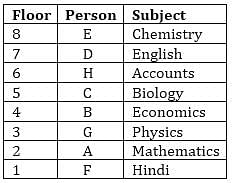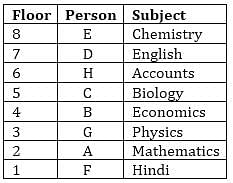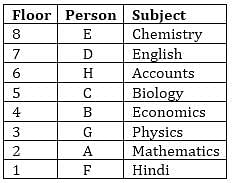NABARD Assistant Manager Grade 'A' Practice Test - 4 - Bank Exams MCQ
30 Questions MCQ Test Mock Tests for Banking Exams 2024 - NABARD Assistant Manager Grade 'A' Practice Test - 4
Study the following information to answer the given questions.
Eight persons i.e. P, Q, R, S, T, U, V and W are sitting around a circular table. Four of them face inside and like different car brands i.e. Bentley, Audi, Porsche and Volvo. Remaining four persons face outside and like different bike brands i.e. Yamaha, KTM, Triumph and Kawasaki. All information is not necessarily in the same order.
Two persons sit between P and the one who likes KTM. The one who likes Volvo is not immediate neighbor of P and the one who likes KTM. Three persons sit between R and S. Two persons sits between the one who likes Bentley and the one who likes Porsche. R is immediate neighbor of the person who likes KTM. Two persons sit between S and U. Three persons sits between V and U. The person who likes Kawasaki sits third to the right of V. The person who likes Porsche sits second to the left of R, who likes bike. U does not like bike. V does not like car. Two persons sits between the one who likes Kawasaki and W. The person who likes Volvo is immediate neighbor of one who likes Triumph. U does not sit opposite to the one who likes triumph. Q does not like KTM.
Q. Who among the following sits 3rd to the right of person who likes Yamaha?
Two persons sit between P and the one who likes KTM. The one who likes Volvo is not immediate neighbor of P and the one who likes KTM. Three persons sit between R and S. Two persons sits between the one who likes Bentley and the one who likes Porsche. R is immediate neighbor of the person who likes KTM. Two persons sit between S and U. Three persons sits between V and U. The person who likes Kawasaki sits third to the right of V. The person who likes Porsche sits second to the left of R, who likes bike. U does not like bike. V does not like car. Two persons sits between the one who likes Kawasaki and W. The person who likes Volvo is immediate neighbor of one who likes Triumph. U does not sit opposite to the one who likes triumph. Q does not like KTM.
Study the following information to answer the given questions.
Eight persons i.e. P, Q, R, S, T, U, V and W are sitting around a circular table. Four of them face inside and like different car brands i.e. Bentley, Audi, Porsche and Volvo. Remaining four persons face outside and like different bike brands i.e. Yamaha, KTM, Triumph and Kawasaki. All information is not necessarily in the same order.
Two persons sit between P and the one who likes KTM. The one who likes Volvo is not immediate neighbor of P and the one who likes KTM. Three persons sit between R and S. Two persons sits between the one who likes Bentley and the one who likes Porsche. R is immediate neighbor of the person who likes KTM. Two persons sit between S and U. Three persons sits between V and U. The person who likes Kawasaki sits third to the right of V. The person who likes Porsche sits second to the left of R, who likes bike. U does not like bike. V does not like car. Two persons sits between the one who likes Kawasaki and W. The person who likes Volvo is immediate neighbor of one who likes Triumph. U does not sit opposite to the one who likes triumph. Q does not like KTM.
Q. How many persons are sitting between the one who likes Audi and T. when counted from left of T?
Two persons sit between P and the one who likes KTM. The one who likes Volvo is not immediate neighbor of P and the one who likes KTM. Three persons sit between R and S. Two persons sits between the one who likes Bentley and the one who likes Porsche. R is immediate neighbor of the person who likes KTM. Two persons sit between S and U. Three persons sits between V and U. The person who likes Kawasaki sits third to the right of V. The person who likes Porsche sits second to the left of R, who likes bike. U does not like bike. V does not like car. Two persons sits between the one who likes Kawasaki and W. The person who likes Volvo is immediate neighbor of one who likes Triumph. U does not sit opposite to the one who likes triumph. Q does not like KTM.
| 1 Crore+ students have signed up on EduRev. Have you? Download the App |
Study the following information to answer the given questions.
Eight persons i.e. P, Q, R, S, T, U, V and W are sitting around a circular table. Four of them face inside and like different car brands i.e. Bentley, Audi, Porsche and Volvo. Remaining four persons face outside and like different bike brands i.e. Yamaha, KTM, Triumph and Kawasaki. All information is not necessarily in the same order.
Two persons sit between P and the one who likes KTM. The one who likes Volvo is not immediate neighbor of P and the one who likes KTM. Three persons sit between R and S. Two persons sits between the one who likes Bentley and the one who likes Porsche. R is immediate neighbor of the person who likes KTM. Two persons sit between S and U. Three persons sits between V and U. The person who likes Kawasaki sits third to the right of V. The person who likes Porsche sits second to the left of R, who likes bike. U does not like bike. V does not like car. Two persons sits between the one who likes Kawasaki and W. The person who likes Volvo is immediate neighbor of one who likes Triumph. U does not sit opposite to the one who likes triumph. Q does not like KTM.
Q. How many persons are sitting between S and T when counted from left of S?
Two persons sit between P and the one who likes KTM. The one who likes Volvo is not immediate neighbor of P and the one who likes KTM. Three persons sit between R and S. Two persons sits between the one who likes Bentley and the one who likes Porsche. R is immediate neighbor of the person who likes KTM. Two persons sit between S and U. Three persons sits between V and U. The person who likes Kawasaki sits third to the right of V. The person who likes Porsche sits second to the left of R, who likes bike. U does not like bike. V does not like car. Two persons sits between the one who likes Kawasaki and W. The person who likes Volvo is immediate neighbor of one who likes Triumph. U does not sit opposite to the one who likes triumph. Q does not like KTM.
Study the following information to answer the given questions.
Eight persons i.e. P, Q, R, S, T, U, V and W are sitting around a circular table. Four of them face inside and like different car brands i.e. Bentley, Audi, Porsche and Volvo. Remaining four persons face outside and like different bike brands i.e. Yamaha, KTM, Triumph and Kawasaki. All information is not necessarily in the same order.
Two persons sit between P and the one who likes KTM. The one who likes Volvo is not immediate neighbor of P and the one who likes KTM. Three persons sit between R and S. Two persons sits between the one who likes Bentley and the one who likes Porsche. R is immediate neighbor of the person who likes KTM. Two persons sit between S and U. Three persons sits between V and U. The person who likes Kawasaki sits third to the right of V. The person who likes Porsche sits second to the left of R, who likes bike. U does not like bike. V does not like car. Two persons sits between the one who likes Kawasaki and W. The person who likes Volvo is immediate neighbor of one who likes Triumph. U does not sit opposite to the one who likes triumph. Q does not like KTM.
Q. Which of the following is true regarding V?
Study the following information to answer the given questions.
Eight persons i.e. P, Q, R, S, T, U, V and W are sitting around a circular table. Four of them face inside and like different car brands i.e. Bentley, Audi, Porsche and Volvo. Remaining four persons face outside and like different bike brands i.e. Yamaha, KTM, Triumph and Kawasaki. All information is not necessarily in the same order.
Two persons sit between P and the one who likes KTM. The one who likes Volvo is not immediate neighbor of P and the one who likes KTM. Three persons sit between R and S. Two persons sits between the one who likes Bentley and the one who likes Porsche. R is immediate neighbor of the person who likes KTM. Two persons sit between S and U. Three persons sits between V and U. The person who likes Kawasaki sits third to the right of V. The person who likes Porsche sits second to the left of R, who likes bike. U does not like bike. V does not like car. Two persons sits between the one who likes Kawasaki and W. The person who likes Volvo is immediate neighbor of one who likes Triumph. U does not sit opposite to the one who likes triumph. Q does not like KTM.
Q. Four of the following five are alike in certain way based from a group, find the one which does not belong to that group?
Study the following information to answer the given questions.
In certain code language,
‘Development Trend People’ is coded as ‘tr le me’
‘Follow Sequence Order’ is coded as ‘ow qu rl’
‘Trend development Sequence’ is coded as ‘me tr qu’
‘Order Common Square’ is coded as ‘rl co re’
Q. What is the code for ‘Common’ in the given code language?
Study the following information to answer the given questions.
In certain code language,
‘Development Trend People’ is coded as ‘tr le me’
‘Follow Sequence Order’ is coded as ‘ow qu rl’
‘Trend development Sequence’ is coded as ‘me tr qu’
‘Order Common Square’ is coded as ‘rl co re’
Q. What is the code for ‘Development’ in the given code language?
Study the following information to answer the given questions.
In certain code language,
‘Development Trend People’ is coded as ‘tr le me’
‘Follow Sequence Order’ is coded as ‘ow qu rl’
‘Trend development Sequence’ is coded as ‘me tr qu’
‘Order Common Square’ is coded as ‘rl co re’
Q. What may be the code for ‘People Follow Trend’ in the given code language?
In each of the questions below are given some statements followed by two conclusions. You have to take the given statements to be true even if they seem to be at variance with commonly known facts. Read all the conclusions and then decide which of the given conclusions logically follows from the given statements disregarding commonly known facts.
Statements: All Red are Bull. All Wings are Fly. No Red is Wings.
Conclusion
I: Some fly are not Bull
II: Some Bull can be fly
In each of the questions below are given some statements followed by two conclusions. You have to take the given statements to be true even if they seem to be at variance with commonly known facts. Read all the conclusions and then decide which of the given conclusions logically follows from the given statements disregarding commonly known facts.
Statements: All Logical are critical. Some logical are Puzzle.
Conclusion
I: All Puzzle are Critical
II: Some Puzzle are not Critical
Study the information carefully and answer the questions given below.
Eight persons i.e. A, B, C, D, E, F, G and H are living in different floors of eight floored building. Each of them teaches different subjects i.e. Hindi, English, Mathematics, Physics, Chemistry, Accounts, Economics and Biology. All information is not necessarily in the same order.
Three persons live between D and G. D lives at odd numbered floor. G does not live on 5th floor. One person lives between the one who teaches Biology and D. B does not live at odd numbered floor. Three persons live between the one who teaches Physics and the one who teaches English. The person who teaches physics lives at odd numbered floor. D does not teach Physics. A lives on second floor. One person lives between one who teaches accounts and the one who teaches Economics. The one who teaches Biology does not live above the one who teaches Chemistry. Two persons live between C and the one, who teaches Chemistry, who lives immediate above floor of the one who teaches English. Four persons live between the one who teaches accounts and the person who teaches Hindi. H lives above B and below E. A does not teaches Accounts.
Q. Who among the following person teaches Economics?
Study the information carefully and answer the questions given below.
Eight persons i.e. A, B, C, D, E, F, G and H are living in different floors of eight floored building. Each of them teaches different subjects i.e. Hindi, English, Mathematics, Physics, Chemistry, Accounts, Economics and Biology. All information is not necessarily in the same order.
Three persons live between D and G. D lives at odd numbered floor. G does not live on 5th floor. One person lives between the one who teaches Biology and D. B does not live at odd numbered floor. Three persons live between the one who teaches Physics and the one who teaches English. The person who teaches physics lives at odd numbered floor. D does not teach Physics. A lives on second floor. One person lives between one who teaches accounts and the one who teaches Economics. The one who teaches Biology does not live above the one who teaches Chemistry. Two persons live between C and the one, who teaches Chemistry, who lives immediate above floor of the one who teaches English. Four persons live between the one who teaches accounts and the person who teaches Hindi. H lives above B and below E. A does not teaches Accounts.
Q. How many persons lives between the person who teaches accounts and G?
Study the information carefully and answer the questions given below.
Eight persons i.e. A, B, C, D, E, F, G and H are living in different floors of eight floored building. Each of them teaches different subjects i.e. Hindi, English, Mathematics, Physics, Chemistry, Accounts, Economics and Biology. All information is not necessarily in the same order.
Three persons live between D and G. D lives at odd numbered floor. G does not live on 5th floor. One person lives between the one who teaches Biology and D. B does not live at odd numbered floor. Three persons live between the one who teaches Physics and the one who teaches English. The person who teaches physics lives at odd numbered floor. D does not teach Physics. A lives on second floor. One person lives between one who teaches accounts and the one who teaches Economics. The one who teaches Biology does not live above the one who teaches Chemistry. Two persons live between C and the one, who teaches Chemistry, who lives immediate above floor of the one who teaches English. Four persons live between the one who teaches accounts and the person who teaches Hindi. H lives above B and below E. A does not teaches Accounts.
Q. Four of the following five are alike in certain way based from a group, find the one that does not belong to that group?
Study the information carefully and answer the questions given below.
Eight persons i.e. A, B, C, D, E, F, G and H are living in different floors of eight floored building. Each of them teaches different subjects i.e. Hindi, English, Mathematics, Physics, Chemistry, Accounts, Economics and Biology. All information is not necessarily in the same order.
Three persons live between D and G. D lives at odd numbered floor. G does not live on 5th floor. One person lives between the one who teaches Biology and D. B does not live at odd numbered floor. Three persons live between the one who teaches Physics and the one who teaches English. The person who teaches physics lives at odd numbered floor. D does not teach Physics. A lives on second floor. One person lives between one who teaches accounts and the one who teaches Economics. The one who teaches Biology does not live above the one who teaches Chemistry. Two persons live between C and the one, who teaches Chemistry, who lives immediate above floor of the one who teaches English. Four persons live between the one who teaches accounts and the person who teaches Hindi. H lives above B and below E. A does not teaches Accounts.
Q. Which of the following subject C likes?
Study the information carefully and answer the questions given below.
Eight persons i.e. A, B, C, D, E, F, G and H are living in different floors of eight floored building. Each of them teaches different subjects i.e. Hindi, English, Mathematics, Physics, Chemistry, Accounts, Economics and Biology. All information is not necessarily in the same order.
Three persons live between D and G. D lives at odd numbered floor. G does not live on 5th floor. One person lives between the one who teaches Biology and D. B does not live at odd numbered floor. Three persons live between the one who teaches Physics and the one who teaches English. The person who teaches physics lives at odd numbered floor. D does not teach Physics. A lives on second floor. One person lives between one who teaches accounts and the one who teaches Economics. The one who teaches Biology does not live above the one who teaches Chemistry. Two persons live between C and the one, who teaches Chemistry, who lives immediate above floor of the one who teaches English. Four persons live between the one who teaches accounts and the person who teaches Hindi. H lives above B and below E. A does not teaches Accounts.
Q. Which of the following combination is true?
Statement-Terming the Goods and Services Tax (GST) is a “revolutionary step”, Minister Mukhtar Abbas Naqvi said that the historic step has been taken in the interest of common people and small traders and is believed to be a game changer for Indian economy. GST is a Great Step towards Transparency by removing multiple taxes and procedures into One Tax regime.
Q. Which of the following negates the given statement?
(I) GST is a “good and simple tax” which will eliminate the compounding effects of multi-layered tax system. There will be absolutely no problem to common people and small traders or big industrialists.
(II) One of the major benefits of GST is that it will ensure transparency in the entire taxation system. It is an historic step, a historic achievement for India. In the new system, there will be “one country, one tax”.
(III) GST is a mystifying term where double tax is charged in the name of a single tax.
Statement-A five-judge Constitution Bench of the Supreme Court will hear a bunch of petitions urgently, challenging the constitutionality of the Aadhaar project, primarily whether the parting of biometric details by citizens to access welfare and benefits under the scheme is a violation of the right to privacy.
Q. Which of the following can be hypothesized from the given statement?
(I) Constitution Bench will decide whether a person can voluntarily shed his right to privacy by enrolling for Aadhaar to access government welfare services.
(II) This is the first time that the Centre has formally joined the petitioners' side and agreed to hear a set of petitions.
(III) The Aadhaar scheme touched the lives of millions of people and its validity required immediate adjudication by an appropriate larger Bench.
Each of the questions below consists of a question and two statements numbered I and II given below it. You have to decide whether the data provided in the statement are sufficient to answer the question. Read both the statements and Give answer:
Six Boxes P, Q, R, S, T and U are kept one above the other than Which box is placed just above box S?
I. Box U placed above box T and below box P but not immediate above or below.
II. Box R placed immediate below box T. one box is placed between S and Q.
Each of the questions below consists of a question and two statements numbered I and II given below it. You have to decide whether the data provided in the statement are sufficient to answer the question. Read both the statements and Give answer:
Among P, Q, R, S and T each one of them has different age, who is the youngest person?
I. Q is elder than only two persons. P is elder than S.
II. R is younger than T. S is elder than T.
Each of the questions below consists of a question and two statements numbered I and II given below it. You have to decide whether the data provided in the statement are sufficient to answer the question. Read both the statements and Give answer:
Who among L, O, S and T reached school second?
I. O reached after L and before T. S reached before only one person.
II. Two person reached after O.
In the given questions, two quantities are given, one as ‘Quantity I’ and another as ‘Quantity II’. You have to determine relationship between two quantities and choose the appropriate option :
A boat can cover 28.8 km distance in downstream in 48 min. and ratio between speed of stream and speed of boat in still water is 2 : 7.
Quantity I –'x' : ‘x’ is the time taken by car to cover a distance of 520 km. Speed of car is 300% more than speed of the boat in upstream.
Quantity II –'y': ‘y’ is the time taken by boat to cover distance of 210 km in Still water.
In the given questions, two quantities are given, one as ‘Quantity I’ and another as ‘Quantity II’. You have to determine relationship between two quantities and choose the appropriate option :
Quantity I – ‘x’ ; In ‘x’ ways a word of 5 different letter can be formed via using only 2 vowel at a time.
Quantity II – 2.5 × 619200
In the given questions, two quantities are given, one as ‘Quantity I’ and another as ‘Quantity II’. You have to determine relationship between two quantities and choose the appropriate option :
Quantity I - ‘x’ : ‘x’ is total number of outlet pipes. Tank is attached by 8 taps. some of which are outlet and some are inlet. Efficiency of all outlet pipe and inlet pipes are same. Time taken by an outlet pipe to empty the tank is double of the time taken by all the pipes (8 pipes) to fill the tank.
Quantity II – 3
In the given questions, two quantities are given, one as ‘Quantity I’ and another as ‘Quantity II’. You have to determine relationship between two quantities and choose the appropriate option :
Quantity I – ‘x’ :  , x : y = 5 : 9 and z = x + 6
, x : y = 5 : 9 and z = x + 6
Quantity II- Area of circle is 472 sq. cm more than area of square, and perimeter of square is 48 cm. Radius of circle.
Given below bar graph shows percentage increment (in kg) in production of total crop (Rice + wheat) and also shows percentage increment (in kg) in production of rice in the five successive years. Read the data carefully and answer the question.
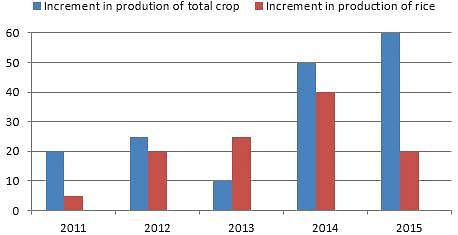
Note - Out of total production of crop in the year 2010, 60% crop is wheat.
Q. If Difference between total rice & wheat production in the year 2011 is 270 kg, then find the Total crop production in the year 2014?
Given below bar graph shows percentage increment (in kg) in production of total crop (Rice + wheat) and also shows percentage increment (in kg) in production of rice in the five successive years. Read the data carefully and answer the question.
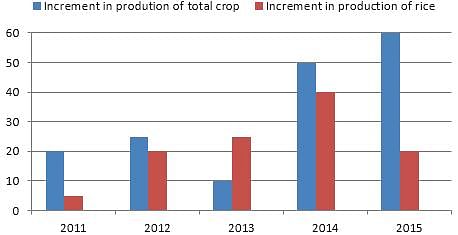
Note - Out of total production of crop in the year 2010, 60% crop is wheat.
Q. Total wheat production in the year 2013 is approximate what percent of total crop production in the year 2015?
Given below bar graph shows percentage increment (in kg) in production of total crop (Rice + wheat) and also shows percentage increment (in kg) in production of rice in the five successive years. Read the data carefully and answer the question.
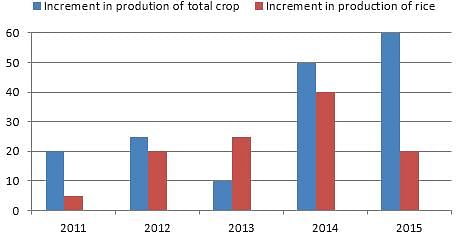
Note - Out of total production of crop in the year 2010, 60% crop is wheat.
Q. Total wheat production in the year 2012 is 4980 kg, then find total wheat production in the year 2014?
Given below bar graph shows percentage increment (in kg) in production of total crop (Rice + wheat) and also shows percentage increment (in kg) in production of rice in the five successive years. Read the data carefully and answer the question.

Note - Out of total production of crop in the year 2010, 60% crop is wheat.
Q. Find the ratio between total wheat productions in the year 2013 to total crop production in the year 2014?
Given below bar graph shows percentage increment (in kg) in production of total crop (Rice + wheat) and also shows percentage increment (in kg) in production of rice in the five successive years. Read the data carefully and answer the question.

Note - Out of total production of crop in the year 2010, 60% crop is wheat.
Q. If total wheat production in the year 2015 is 1450.8 kg, then find the rice production in the year 2013?
Given below bar graph shows percentage increment (in kg) in production of total crop (Rice + wheat) and also shows percentage increment (in kg) in production of rice in the five successive years. Read the data carefully and answer the question.

Note - Out of total production of crop in the year 2010, 60% crop is wheat.
Q. Total wheat production in the year 2013 is approximate what percent less than of total crop production in the year 2014?
|
160 tests
|


